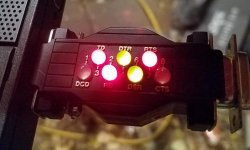Cooperstock
Aluminum
- Joined
- Apr 13, 2015
Hello,
This is an extension of a previous trouble shooting on this machine.
I have got to the point where I am working on the communications to/from the Machine.
I have a laptop and have loaded Cadems NCLite DNC software
I have looked at the registers in the Matsuura to verify stop bits and baud rate and played with data bits.
The machine is setup only to use the 2nd RS232 port (doesn't seem to be an issue that I can tell) the 1st port is not enabled.
One thing I have not changed is the length of the RS232 cable...it maybe close to 30ft. The previous owner was using it so I haven't messed with it...but possibly an issue.
I have attached pictures of the machine port settings, the DNC software setting and the file received FROM the matsuura
Per a suggestion from other posts, I worked on getting the data out of the matsuura in the correct format, the picture attached is the output registers from the Matsuura.
Using the same settings I attempt to send a file to Matsuura. I get an error 077 which states '10 characters or more were read after stop code was issued'
It seems the machine and laptop arn't talking quite correctly.
I tried changing the hand shake method but on other settings it did not seem to work at all.
Any thoughts as to why I would be able to receive a file that looks correct but not be able to send one to the machine?
I have also attached the page from the manual that describes the parameter settings for the MX3. Maybe i am reading it wrong as well.
Thanks
David




This is an extension of a previous trouble shooting on this machine.
I have got to the point where I am working on the communications to/from the Machine.
I have a laptop and have loaded Cadems NCLite DNC software
I have looked at the registers in the Matsuura to verify stop bits and baud rate and played with data bits.
The machine is setup only to use the 2nd RS232 port (doesn't seem to be an issue that I can tell) the 1st port is not enabled.
One thing I have not changed is the length of the RS232 cable...it maybe close to 30ft. The previous owner was using it so I haven't messed with it...but possibly an issue.
I have attached pictures of the machine port settings, the DNC software setting and the file received FROM the matsuura
Per a suggestion from other posts, I worked on getting the data out of the matsuura in the correct format, the picture attached is the output registers from the Matsuura.
Using the same settings I attempt to send a file to Matsuura. I get an error 077 which states '10 characters or more were read after stop code was issued'
It seems the machine and laptop arn't talking quite correctly.
I tried changing the hand shake method but on other settings it did not seem to work at all.
Any thoughts as to why I would be able to receive a file that looks correct but not be able to send one to the machine?
I have also attached the page from the manual that describes the parameter settings for the MX3. Maybe i am reading it wrong as well.
Thanks
David











